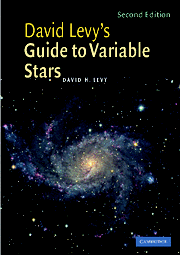Book contents
- Frontmatter
- Contents
- Foreword to the first edition
- Preface
- Acknowledgments
- Part I Getting to know the sky
- Part II Getting to know the variables
- Part III Suggested variables for observation throughout the year
- 26 Introduction
- 27 January, February, March
- 28 April, May, June
- 29 July, August, September
- 30 October, November, December
- 31 Southern sky notes
- Part IV A miscellany
- Index
31 - Southern sky notes
from Part III - Suggested variables for observation throughout the year
Published online by Cambridge University Press: 05 August 2012
- Frontmatter
- Contents
- Foreword to the first edition
- Preface
- Acknowledgments
- Part I Getting to know the sky
- Part II Getting to know the variables
- Part III Suggested variables for observation throughout the year
- 26 Introduction
- 27 January, February, March
- 28 April, May, June
- 29 July, August, September
- 30 October, November, December
- 31 Southern sky notes
- Part IV A miscellany
- Index
Summary
For the benefit of southern hemisphere observers, I include a selection of variables that are prominent there. More information about southern stars can be obtained from the Variable Star Section of the Royal Astronomical Society of New Zealand, or the AAVSO.
These are the far southern stars – not simply southern-hemisphere variables, but stars so far south that they are not visible to observers at most northern latitudes. In other chapters, we have explored constellations in the southern sky that are visible from much of the north – like Canis Major (27.8), Monoceros (27.10), Puppis (27.11), Hydra (28.9), Libra (28.12), Lupus (28.13), Scorpius (29.6), Sagittarius (29.7), Corona Austrina (29.8), Capricornus (30.1), and Cetus (30.11).
If you live in the southern hemisphere, you have the privilege of watching the antics of these stars at almost any time. If you live in the northern hemisphere, you may someday visit the south, where this array of variable stars awaits you.
The region of the southern sky that begins with Alpha Centauri (the nearest star system to the Sun) and continues through Beta Centauri, the Coal Sack Nebula, the Southern Cross, ending with Eta Carinae, is perhaps the most spectacular portion of the entire heavens. It is well worth a trip to the southern hemisphere just to see it, especially when it is well placed in the sky of southern-hemisphere winter.
Apus
145971 S Apodis. An R Coronae Borealis star with a maximum of 9.6 and minimum of 15.2. Fainter maximum, but approximately same minimum as RY Sgr. Level 4.
[…]
- Type
- Chapter
- Information
- David Levy's Guide to Variable Stars , pp. 229 - 234Publisher: Cambridge University PressPrint publication year: 2005

